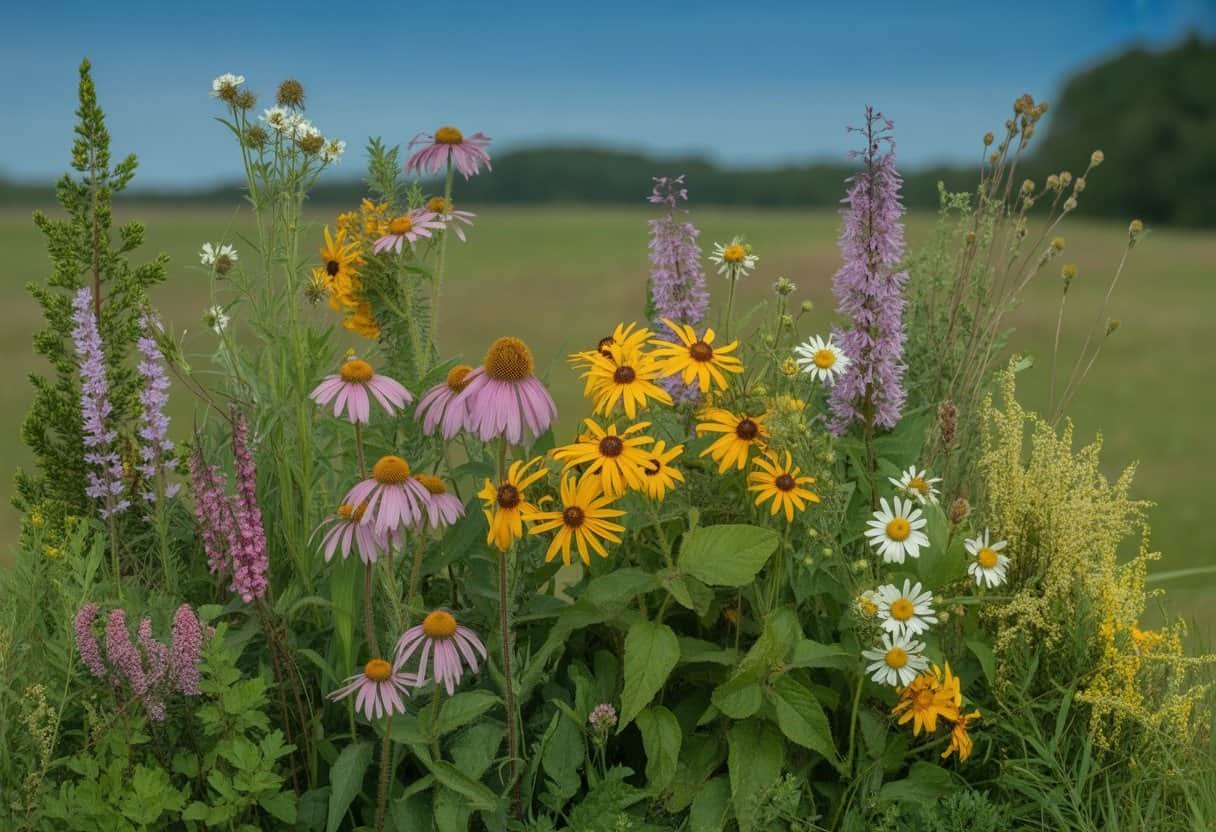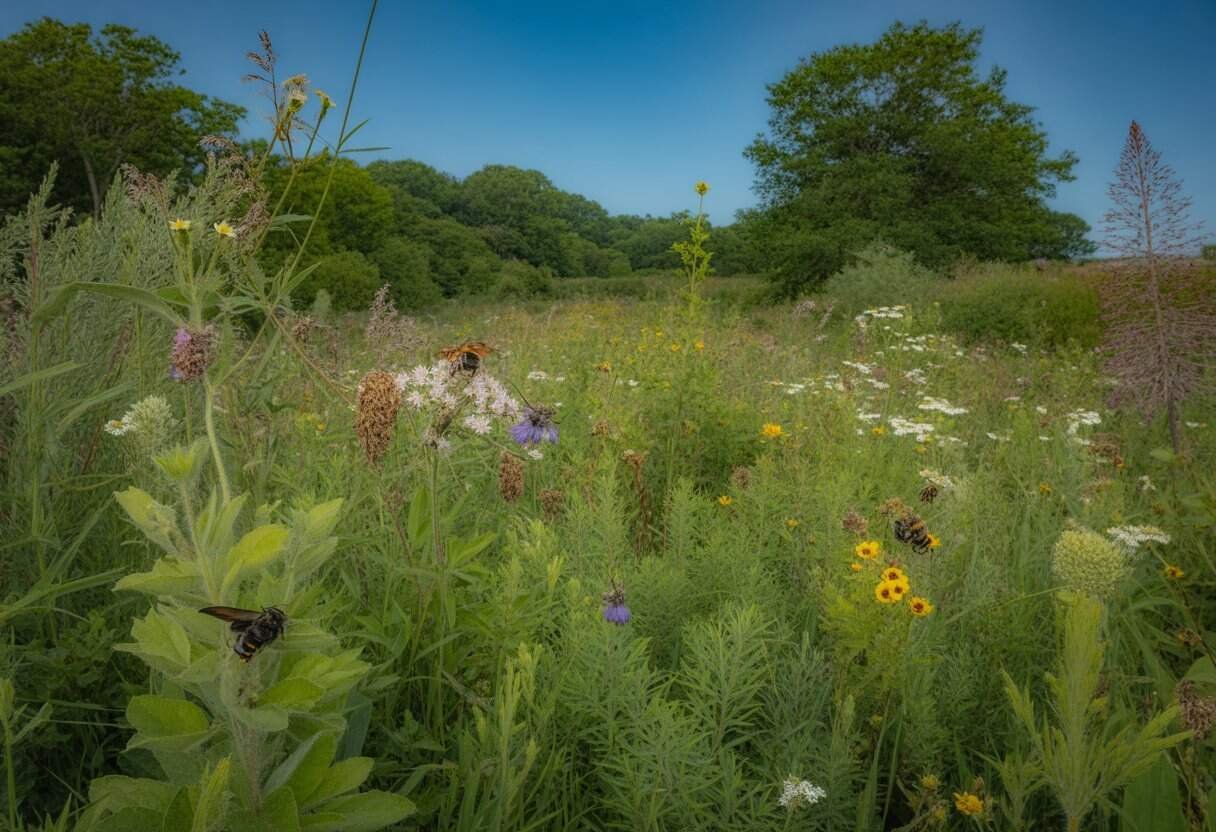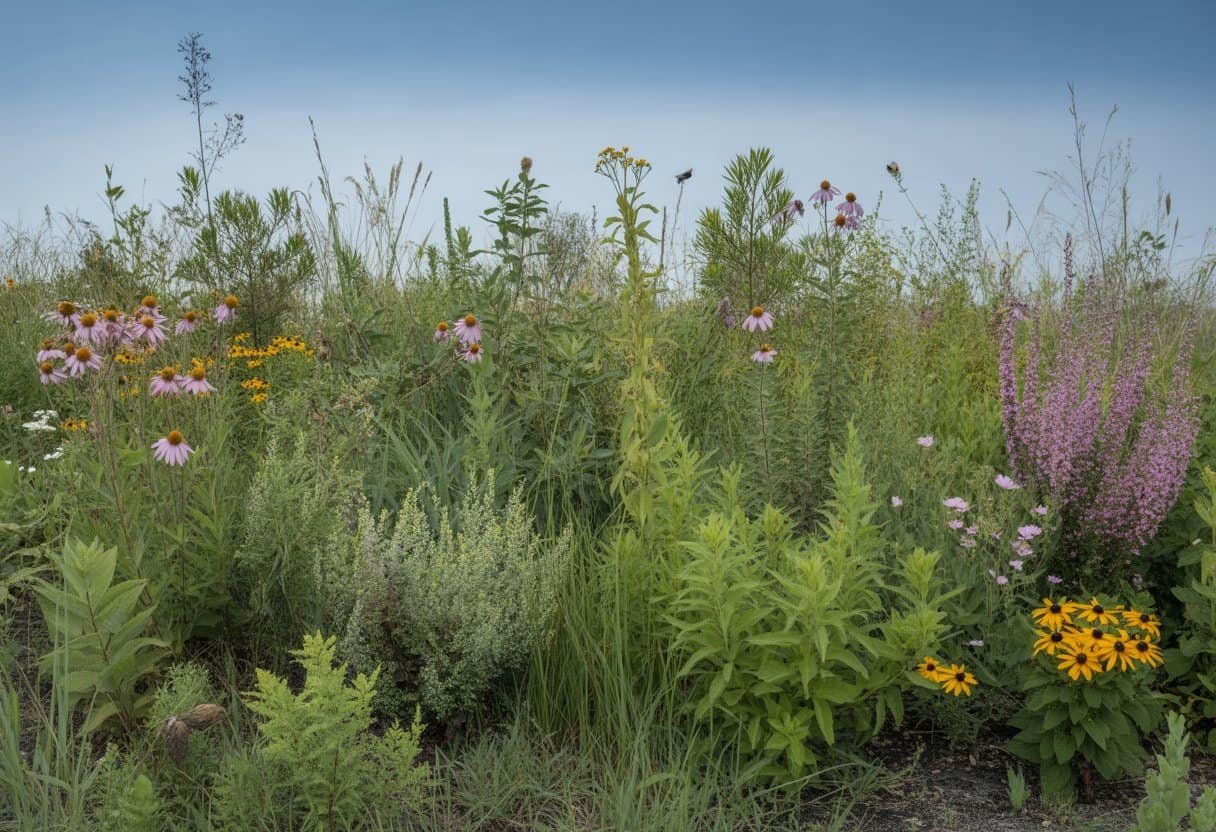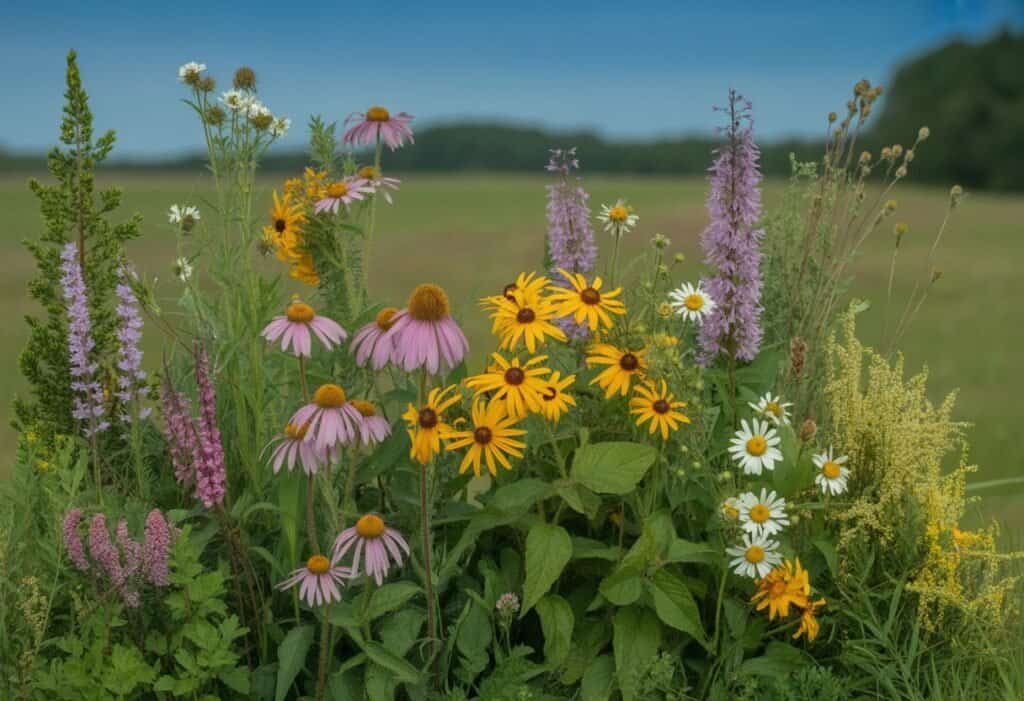Wisconsin’s native plants have thrived in our local soils and climate for thousands of years. These indigenous species create the natural beauty that defines our state’s landscape.
They have deep roots in Wisconsin’s history and ecology, from the prairies of the south to the northwoods forests. Growing native plants in your Wisconsin garden supports local wildlife and reduces maintenance needs.
Native plants also help preserve our state’s natural heritage.

Native plants offer many advantages over non-native alternatives. They need less water and fertilizer once established because they’ve adapted to local conditions.
Many Wisconsin natives like purple coneflower, wild bergamot, and butterfly weed add vibrant colors to gardens. They also provide essential habitat for birds, butterflies, and beneficial insects.
Key Takeaways
- Wisconsin native plants support local pollinators and wildlife while requiring less maintenance than non-native species.
- Native plants have adapted to local soil and climate conditions, making them more resilient during weather extremes.
- Incorporating indigenous species like prairie grasses, woodland flowers, and wetland plants helps preserve Wisconsin’s unique ecological heritage.
Understanding Wisconsin Native Plants
Wisconsin’s landscape features a rich variety of plants that evolved in our region over thousands of years. These native species play crucial roles in supporting local wildlife and maintaining healthy ecosystems.
Definition of Native Species
Native plants are species that occurred naturally in Wisconsin before European settlement. These plants adapted over thousands of years to local soil conditions, rainfall patterns, and seasonal temperature changes.
Wisconsin’s native flora includes over 2,000 species, from towering white pines to delicate prairie flowers. Native plants have deep historical connections to the region.
They formed complex relationships with local wildlife, fungi, and microorganisms long before human development. Many Wisconsin natives are hardy and have developed natural defenses against local pests and diseases.
They thrive without chemical interventions. Examples include purple coneflower, wild bergamot, and big bluestem grass.
Benefits for Local Ecosystems
Native plants provide essential food and shelter for Wisconsin wildlife. Many local insects feed only on specific native plants they co-evolved with.
For example, monarch butterflies depend entirely on milkweed to reproduce. These plants also support soil health.
Their extensive root systems prevent erosion and improve water quality by filtering runoff before it reaches lakes and streams. Wisconsin natives require less maintenance once established.
They typically need minimal watering, fertilizing, or pest control compared to non-native ornamentals. Native plant communities increase biodiversity and ecosystem resilience.
A yard with diverse native species can support many more bird and butterfly species than a conventional lawn.
Distinguishing Natives from Invasive Plants
Invasive plants are non-native species that spread aggressively and often outcompete native flora. Common Wisconsin invasives include garlic mustard, buckthorn, and purple loosestrife.
Invasives disrupt natural ecosystems. Several key features help identify native plants:
- Growth pattern: Natives typically grow in harmony with surrounding plants
- Root structure: Many natives develop deep, soil-enriching root systems
- Seasonal behavior: Natives follow natural local growth cycles
Wisconsin’s Department of Natural Resources provides helpful resources for plant identification. Their field guides show distinctive leaf shapes, flower structures, and growth habits of common natives.
When landscaping, check plant origins carefully. Many nurseries now specialize in Wisconsin native species and offer plants grown from local seed sources.
Ecological Roles and Benefits

Wisconsin native plants serve as the foundation of healthy ecosystems throughout the state. They fulfill critical ecological functions that maintain biodiversity and support the web of life in forests, prairies, wetlands, and other natural areas.
Supporting Birds and Wildlife
Native plants provide essential habitat and food sources for Wisconsin’s wildlife. Birds rely on these plants for nesting materials, shelter, and nutrition.
Cardinals and chickadees eat seeds from coneflowers and asters, while warblers hunt insects that live on native trees. Woodland species like oak trees support hundreds of caterpillar species, which become food for nesting birds.
Each native bird chick may eat thousands of caterpillars before leaving the nest. Native shrubs like American hazelnut and serviceberry offer protective cover for small mammals and birds.
Their dense branches shield wildlife from predators and harsh weather. Wisconsin’s native white pine, red oak, and maple trees create vertical habitat layers.
Squirrels, woodpeckers, and owls each use different parts of these native tree communities.
Value for Pollinators and Butterflies
Wisconsin’s native wildflowers have co-evolved with local pollinators. Native bees, like the rusty-patched bumble bee, depend on specific native plants that bloom from spring through fall.
Butterflies require particular native plants as hosts for their caterpillars. Monarch butterflies need milkweed species, while fritillaries depend on native violets.
Without these host plants, these butterfly species cannot complete their life cycles. Native pollinators have specialized relationships with native flowers.
Some long-tongued bee species pollinate plants with deep flower tubes that non-native bees cannot access. Early-blooming native plants like wild geranium and columbine provide critical food for pollinators emerging from winter.
Late bloomers like goldenrod and asters offer final nutrition before winter.
Contribution to the Food Web
Native plants form the base of Wisconsin’s food web. Their leaves, seeds, fruits, and roots feed many species.
Insects that evolved with native plants have digestive systems that can process the specific chemical compounds in these plants. Non-native plants often lack these relationships, creating “food deserts” for local insects.
Native predators depend on the insects supported by native plants. Frogs, bats, and insect-eating birds all benefit from healthy populations of native insects.
Underground, native plant root systems support communities of fungi, bacteria, and other microorganisms. These relationships help cycle nutrients and maintain soil health.
Wisconsin’s native berry producers like elderberry and blackberry provide essential calories for migrating birds. These energy-rich fruits appear when birds need them most.
Conservation and Sustainability
Planting natives conserves water because these species have adapted to local rainfall patterns. Their deep root systems improve soil structure and reduce erosion during heavy rains.
Areas rich in native plants need less maintenance and fewer resources than non-native landscapes. Many native plants thrive without extra watering once established.
Native plant communities capture carbon and help reduce climate change impacts. Prairie plants especially excel at carbon sequestration with their massive root systems.
Restoring native plant communities creates resilient ecosystems that better withstand environmental stresses. During drought, established native plants typically survive while non-natives struggle.
Wisconsin’s native plant nurseries and seed companies provide locally-adapted ecotypes that preserve genetic diversity. Using these local varieties in restoration projects increases success rates and maintains regional biodiversity.
Native Plant Habitats and Adaptations

Wisconsin native plants have evolved specific traits to thrive in the state’s diverse environments. These adaptations help plants survive in various soil types, moisture levels, and temperature conditions.
Woodlands and Shade Environments
Woodland native plants have adapted to life under the forest canopy where sunlight is limited. Species like Wild Ginger, Jack-in-the-Pulpit, and various ferns have large leaf surfaces to capture the little sunlight that filters through the trees.
These plants often bloom early in spring before trees leaf out fully. This timing lets them photosynthesize and complete their reproductive cycle when more light reaches the forest floor.
Woodland soils tend to be rich in organic matter from fallen leaves. Plants in these habitats usually prefer moist, well-draining soils with higher acidity.
Many develop shallow, spreading root systems to gather nutrients from the top layer of soil. Temperature fluctuations are less extreme in woodland settings because the tree canopy moderates both heat and cold.
Prairies and Grasslands
Prairie plants thrive in open areas with full sun exposure and challenging conditions. Many species develop deep root systems—sometimes extending 15 feet deep—to access water during drought.
Native grasses like Big Bluestem and Little Bluestem form the backbone of these ecosystems. Their dense root networks help prevent soil erosion and build rich topsoil.
Prairie plants are often drought-tolerant with narrow leaves or hairy surfaces that reduce water loss. Some species, like Compass Plant, position their leaves to minimize sun exposure during the hottest part of the day.
Key Prairie Plant Adaptations:
- Deep, extensive root systems
- Drought resistance mechanisms
- Fire adaptation (resprouting from root crowns)
- Wind pollination in many species
These plants evolved alongside periodic fires and grazing. They developed strategies to regrow quickly after disturbance.
Wetlands, Ponds, and Rain Gardens
Wetland plants have specialized adaptations for life in saturated soils or standing water. Many develop aerenchyma—air channels in roots and stems that let oxygen reach submerged plant parts.
Some species, like Swamp Milkweed and Blue Flag Iris, thrive in consistently wet soils around ponds and streams. Others, such as Cardinal Flower, prefer the transitional zones between dry and wet areas.
Rain garden plants must tolerate both periodic flooding and dry spells. Joe-Pye Weed and Fox Sedge handle these fluctuating conditions well.
Wetland plants often spread through rhizomes, creating dense colonies that help stabilize shorelines and filter pollutants from water. Many feature bright flowers that attract important pollinators to these biodiverse habitats.
Climate change is affecting Wisconsin’s wetlands. Plants that can adapt to variable moisture conditions are increasingly valuable in landscape design.
Popular Wisconsin Native Plant Species
Wisconsin’s diverse landscape is home to a remarkable variety of native plants that have evolved to thrive in local conditions. These plants support local wildlife, need less maintenance once established, and contribute to the state’s ecological health.
Flowering Plants and Wildflowers
Wild Columbine (Aquilegia canadensis) is one of Wisconsin’s most distinctive native flowers. Its red and yellow nodding blooms appear in spring and attract hummingbirds and butterflies.
This adaptable plant grows in both rocky outcrops and woodland edges. Black-eyed Susan (Rudbeckia hirta) brightens summer landscapes with golden-yellow petals surrounding a dark center cone.
These drought-tolerant plants grow 1-3 feet tall and bloom from June through October, providing long-lasting color. Bee Balm (Monarda fistulosa), also called Wild Bergamot, produces lavender flowers that attract pollinators.
Its aromatic foliage has a minty scent and was traditionally used by Native Americans for tea. New England Aster offers vibrant purple blooms in late summer when many other flowers have faded.
These plants can reach 5 feet tall and provide important late-season nectar for migrating monarchs. Swamp Milkweed (Asclepias incarnata) thrives in wet areas, producing pink flower clusters that serve as essential habitat for monarch butterflies.
Its seed pods release silky seeds in fall, creating a dramatic display.
Native Trees and Shrubs
American Beech trees have smooth gray bark and a spreading canopy. They produce small nuts that feed wildlife and can live for hundreds of years in Wisconsin’s forests.
Sumac varieties bring dramatic red fall color to Wisconsin landscapes. Their berry-like fruits last through winter, feeding birds when food is scarce.
Downy Serviceberry blooms with delicate white flowers in early spring before most trees leaf out. Later, it produces edible purple berries that taste like blueberries and attract many bird species.
Gray Dogwood forms thickets that create valuable wildlife habitat. Its white berries grow on red stems, adding winter interest after leaves drop.
Common Witchhazel stands out among native shrubs for its yellow, spider-like flowers that bloom in late fall. This understory plant grows well in partially shaded woodland edges and can reach 15 feet tall.
Grasses and Groundcovers
Prairie Dropseed (Sporobolus heterolepis) forms elegant fountains of fine-textured foliage. In late summer, it produces airy seed heads that catch morning light and add movement to gardens.
Pennsylvania Sedge creates a lush carpet in shady areas where lawn grasses struggle. It grows well under trees and makes an excellent low-maintenance ground cover.
Little Bluestem changes through the seasons—blue-green in summer, turning rusty orange in fall, and standing upright through winter. Its form provides structure in the landscape year-round.
Woodland Phlox spreads to form colorful mats of lavender-blue flowers in spring. It thrives in partial shade and works well as a groundcover beneath native trees and shrubs.
Canadian Anemone produces white buttercup-like flowers above deeply divided foliage. It spreads by underground runners to form colonies, helping prevent erosion on slopes.
Rare and Unique Native Flora
Culver’s Root (Veronicastrum virginicum) has tall, candelabra-like white flower spikes that can reach 6 feet. Once common in prairies, it’s now less frequently found in the wild.
White Baneberry, or “Doll’s Eyes,” produces striking white berries with black dots on red stems. These toxic fruits are visually fascinating in woodland gardens.
Buttonbush thrives in wetland areas and produces spherical white flower heads that look like pincushions. These blooms attract many butterfly species.
Stiff Goldenrod (Solidago rigida) stands out with flat-topped flower clusters instead of arching plumes. It provides a critical late-season nectar source for pollinators.
American Elderberry produces clusters of purple-black berries used in jams and wines. Its compound leaves and large flower clusters make it both ornamental and useful for restoration projects.
Landscape Uses and Garden Design
Wisconsin native plants help create beautiful landscapes that thrive with minimal care. These plants can transform ordinary yards into stunning, ecologically valuable spaces that change with the seasons.
Incorporating Natives into Landscaping
Native plants can replace traditional garden elements while keeping visual appeal. Replace formal hedges with compact shrubs like ninebark or American hazelnut to create natural boundaries and provide food for wildlife.
Arrange garden beds by height, with tall species like joe-pye weed in the back and shorter plants like wild geranium in front. This adds depth and visual interest.
Border paths with low-growing native sedges or Pennsylvania sedge as lawn alternatives. These require no mowing and stay green throughout summer.
Choose native trees like serviceberry or redbud as focal points. These small trees offer spring flowers, summer shade, and fall color in sizes that fit most yards.
Designing with Texture and Seasonal Interest
Wisconsin gardens can showcase beauty year-round with thoughtful native plant selection. Spring starts with woodland ephemerals like bloodroot and trillium. Summer brings prairie flowers such as purple coneflower and black-eyed Susan.
Texture matters in garden design. Pair fine-textured plants like little bluestem grass with bold-leaved joe-pye weed for contrast. This keeps the garden interesting even when plants aren’t flowering.
Fall brings vibrant colors from sumac, chokeberry, and asters. Winter interest comes from ornamental grasses and seed heads. Prairie dropseed and switchgrass stand through winter, catching snow and frost.
Plan for continuous bloom by mapping flowering times. This keeps color in the garden from April through October.
Low-Maintenance Plantings
Native plants reduce garden maintenance once established. Most need no fertilizer, minimal watering, and resist local pests and diseases.
Create easy-care zones with prairie plants like butterfly weed, blazing star, and prairie dropseed. These deep-rooted plants outcompete weeds and thrive in poor soils.
Group plants with similar water needs together. Place moisture-loving plants like cardinal flower and blue lobelia in wet areas. Drought-tolerant plants like prairie smoke and pasqueflower work well in dry spots.
Apply a 2-3 inch layer of mulch around new plantings to suppress weeds and retain moisture. After establishment, native plant communities form their own mulch layer from fallen leaves and stems.
Supporting the Local Ecosystem in Garden Design
Wisconsin native plants form the foundation of healthy local ecosystems. Each native plant supports specific wildlife that has evolved alongside it for thousands of years.
Include host plants for butterfly caterpillars. Milkweed supports monarchs, while wild lupine hosts endangered Karner blue butterflies.
Layer the garden vertically with trees, shrubs, and ground covers to create diverse habitats. This mimics natural plant communities and provides shelter for birds and beneficial insects.
Connect garden spaces to create wildlife corridors. Even small patches of natives can serve as stepping stones for pollinators moving through urban areas.
Choose regional native plant varieties when possible. These adapt best to local growing conditions and benefit local wildlife most.
Planting, Soil Requirements, and Maintenance
Wisconsin native plants thrive with proper site preparation, the right soil conditions, and minimal but consistent care. Match plant species to your specific growing conditions for the best results.
Understanding Soil and Moisture Needs
Wisconsin soils vary from sandy in the north to heavy clay near the Great Lakes. Most native plants prefer well-draining soil with moderate organic matter.
Test your soil before planting to find out its type and pH level. Many Wisconsin natives do best in slightly acidic to neutral soil (pH 5.5-7.0).
Moisture needs differ by species:
- Wet-loving plants: Cardinal flower, Blue flag iris
- Medium moisture: Wild bergamot, Black-eyed Susan
- Drought-tolerant: Prairie dropseed, Butterfly weed
Some plants like Joe-Pye weed need moist soil, while others like prairie coneflower handle dry conditions. Group plants with similar moisture needs together for easier care.
Choosing the Right Plants for Light and Climate
Wisconsin covers USDA hardiness zones 3-5, with different winter temperatures and growing seasons. Select plants native to your specific region for best results.
Light conditions affect plant success:
| Light Level | Example Plants |
|---|---|
| Full sun | Prairie blazing star, Purple coneflower |
| Partial shade | Wild geranium, Zigzag goldenrod |
| Full shade | Wild ginger, Maidenhair fern |
Match plants to your site’s light conditions. Even sun-loving plants may benefit from afternoon shade during the hottest summer days.
Native plant nurseries can help you choose species that fit your local climate and growing conditions. Consider microclimate factors like wind exposure and how close you are to buildings.
Establishment and Ongoing Care
New native plantings need regular watering during their first year, even drought-tolerant species. Once established, most Wisconsin natives need little extra water.
Mulch with 2-3 inches of shredded leaves or wood chips to suppress weeds, retain soil moisture, and protect roots during winter.
Avoid too much fertilizer, which can cause weak, leggy growth. Most natives thrive in moderately fertile soil without added nutrients.
Leave plant stems standing through winter to provide habitat for beneficial insects. Cut back dead growth in early spring before new shoots emerge.
Many native plants spread naturally through seeds or rhizomes. Divide crowded plants every 3-4 years to rejuvenate them and add more specimens to your garden.
Where to Find and Purchase Wisconsin Native Plants
Finding quality Wisconsin native plants starts with knowing where to look and what to look for. Many specialized nurseries and organizations across the state offer native plants suited to your local conditions.
Reputable Local Nurseries and Growers
Johnson’s Nursery in Menomonee Falls specializes in Wisconsin native trees, shrubs, and perennials. They grow most of their stock on site, so plants are adapted to local conditions.
Several farms near Jackson, WI offer native plant sales during the growing season. These smaller operations often give personalized advice on plant selection and care.
In the Green Bay area, native plant nurseries have expanded in recent years. Many focus on prairie and woodland species that support local pollinators.
The Wisconsin DNR keeps a comprehensive list of native plant nurseries on their website, organized by region and specialization.
Distinguishing Nursery Stock and Sourcing
Quality nursery stock has healthy roots and good top growth. Look for plants grown from seed sourced within 200 miles of your planting site for best adaptation.
Native plant tags should list the scientific name and ideally the geographic origin. This helps ensure you get true Wisconsin natives.
Potted plants with roots filling but not circling the container show good nursery practices. Avoid root-bound plants or those showing stress.
Field-grown natives often establish more quickly than container plants. Some nurseries offer bare-root stock in spring and fall, which can be more economical for large plantings.
Wholesale Versus Retail Purchasing
| Purchase Type | Best For | Typical Minimum Order |
|---|---|---|
| Retail | Homeowners | No minimum |
| Wholesale | Restoration projects | $500+ |
| Pre-order | Specific varieties | Varies |
Wholesale growers usually offer better prices but require minimum purchases. These growers serve landscapers and restoration projects, but some work with homeowner groups for community projects.
Retail sales offer more flexibility for small plantings. Many retail nurseries offer weekend workshops to help customers learn about native plant gardening.
Pre-ordering from native plant sales held by conservation groups often gives access to unusual species not found in retail settings.
Helpful Organizations and Events
The Wild Ones organization hosts native plant sales throughout Wisconsin each spring. Their events feature locally grown plants and advice from experienced gardeners.
Annual garden tours showcase successful native plant landscapes. These tours provide inspiration and practical examples of native plants in different settings.
The Wisconsin Native Plant Society offers field trips to natural areas where members can learn to identify plants in their habitats before buying.
Native plant conferences in Madison and Milwaukee provide networking opportunities with growers and experts. Many vendors at these events offer plants not available elsewhere.
Frequently Asked Questions
Wisconsin native plants offer many benefits for home landscapes. These plants adapt to local conditions and support wildlife in Wisconsin.
What are the best native plants for landscaping in Wisconsin?
Top Wisconsin native plants for landscaping include Purple Coneflower, Wild Bergamot, and Black-Eyed Susan. These perennials add color and attract pollinators.
Joe Pye Weed and Prairie Blazing Star work well as background plants in larger gardens. They grow tall and produce showy flowers in late summer.
For shady areas, Wild Ginger, Woodland Phlox, and Zigzag Goldenrod thrive. These plants grow naturally in Wisconsin’s forest understory.
How can I identify Wisconsin native plants?
Plant identification guides specific to Wisconsin help identify native species. The Wisconsin DNR and UW-Extension offer free guides with photos and descriptions.
Key identification features include leaf arrangement, flower structure, and growth habit. Native plant apps can provide instant identification in the field.
Joining a local native plant society gives opportunities to learn from experienced botanists. Many societies offer guided walks to help with identification.
Where can I find a list of native shrubs in Wisconsin?
The Wisconsin DNR website provides comprehensive lists of native shrubs. University of Wisconsin Extension also offers publications featuring native shrubs.
Popular Wisconsin native shrubs include Red Osier Dogwood, American Hazelnut, and Ninebark. These shrubs provide habitat and food for wildlife.
Local native plant nurseries often keep inventories of available native shrubs. Their staff can help you select appropriate species.
Which native trees are commonly found in Wisconsin?
Common native Wisconsin trees include Sugar Maple, White Oak, and Paper Birch. These species form the backbone of Wisconsin’s forests.
Red Maple grows well in wetter areas, while Bur Oak tolerates drier conditions. This diversity allows native trees to thrive across Wisconsin.
Eastern White Pine and Hemlock are important conifer species native to Wisconsin. They provide year-round greenery and wildlife habitat.
Can you recommend native ground covers for Wisconsin gardens?
Wild Strawberry makes an excellent native ground cover with small edible fruits. It spreads by runners and tolerates light foot traffic.
Pennsylvania Sedge works well in shady areas where grass struggles. This grasslike plant forms soft mounds of narrow leaves.
Wild Ginger and Canada Anemone thrive in woodland gardens. They spread gradually to form attractive colonies that suppress weeds.
Which native Wisconsin flowers can I plant to attract pollinators?
Butterfly Weed attracts monarch butterflies and other pollinators. Its bright orange flowers bloom in midsummer.
Wild Lupine supports endangered Karner Blue butterflies. This plant blooms in spring and has distinctive blue flower spikes.
New England Aster and Goldenrod provide important late-season nectar. They bloom when many other flowers have finished.
Wild Bergamot attracts bees, butterflies, and hummingbirds. Its lavender flowers bloom for weeks in summer.


